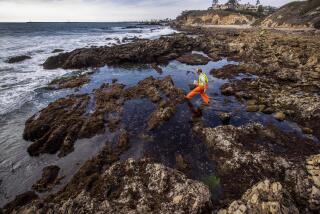NTSB finds discrepancies in San Bruno pipeline records
- Share via
Federal investigators searching for the cause of last fall’s deadly natural gas explosion in San Bruno have found discrepancies in some of the records that describe how the transmission line was built.
The National Transportation Safety Board reported Tuesday that Pacific Gas & Electric records showed the section of pipe that ruptured, killing eight people and destroying dozens of homes, was of a seamless steel construction. But investigators, in an update on their probe, noted the line actually included welded seams.
In addition, some seams running along the length of the pipe were welded only on the outside, investigators said, while others were welded both inside and out.
The combined findings suggested investigators are focusing on a weld failure as one cause of the disaster. But NTSB investigators declined to elaborate, saying their inquiry is still in the early stages, and a final report will not be completed until late next year.
The agency did say it is researching pipe welding standards and practices from 1956, when the 30-inch PG&E transmission line was constructed, to better understand the variances found in welding patterns.
The report revived concerns about the safety of the utility’s pipelines. Assemblyman Jerry Hill (D-San Mateo), who represents San Bruno and is pressing for tougher pipeline regulation, said he was troubled by the recordkeeping problems. “It’s disturbing.... It raises questions about their understanding of their system.”
PG&E officials said they take the discrepancy in records seriously and are investigating. The utility has both seamed and seamless pipe and adheres to all inspection regulations, which are similar for both types of pipeline, company Vice President Kirk Johnson told reporters in a conference call.
“We are very confident of our inspection program,” he said. The ruptured pipeline never experienced a pressure spike exceeding its design limits, he added. And the utility doesn’t dig up pipelines to verify the accuracy of its records without some indication of a problem, he said.
Richard B. Kuprewicz, a pipeline safety expert, said the report “calls into question the integrity” of PG&E’s federally-mandated safety management program. He said older pipelines with welded seams can require more rigorous monitoring. Regulators “put the onus on the operator,” he said. “You’re supposed to know about this stuff, and your records have to be complete.”
Ted Wilke, a former chief of federal pipeline safety, said the varying weld pattern in the ruptured pipe section raises questions, but doesn’t necessarily point to a problem.
“The pipe manufacturing business is a very arcane craft,” he said. “Every method of fabricating a pipe is unique.”
Last September’s explosion in the town just south of San Francisco was one of the deadliest for a gas line in recent U.S. history. It has cost PG&E nearly $250 million in property damage, personal injury compensation, inspection work and other legal expenses. Numerous lawsuits are pending.
The blast occurred after the large transmission line running under a hillside neighborhood began leaking. The explosion blew a 28-foot section of the pipe out of the ground and started a fire that burned more than 50 homes.
The new report seeks to dispel some theories surrounding the tragedy. No physical evidence of earlier leaks from the pipeline was found, investigators said. Some residents reported smelling gas days before the explosion.
Also, no evidence of external corrosion, a leading cause of pipeline failures, was found on ruptured pipe sections, the report says. It does not indicate if internal corrosion was present. But previous reports found no significant deterioration of the pipeline wall thickness.
And no physical signs of excavation damage to the pipeline were documented, the agency said. Work on city sewer lines running near the pipeline had been one focus of media inquiries in the wake of the blast.
Investigators are continuing to examine operations and maintenance of the pipeline, as well as safety oversight, which falls primarily on the California Public Utilities Commission. In a report issued a month after the blast, the NTSB said maintenance work triggered electrical problems at a pipeline control center and a rise in gas pressure just before the explosion.
One ongoing focus of the inquiry is where the initial fracture occurred and how it spread, the NTSB said.
Brigham McCown, another former chief of the federal pipeline safety agency, noted stress corrosion cracking is known to affect older pipe. It can develop as tiny points of corrosion and grow into cracks that can be difficult to find.
“It is something that federal regulators are looking at closely in general,” he said. “It is something that concerns them.”
More to Read
Sign up for Essential California
The most important California stories and recommendations in your inbox every morning.
You may occasionally receive promotional content from the Los Angeles Times.











